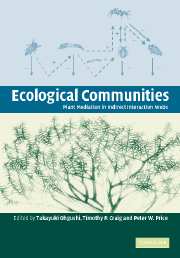Book contents
- Frontmatter
- Contents
- List of contributors
- Preface
- Part I Introduction
- Part II Interaction linkages produced by plant-mediated indirect effects
- Part III Plant-mediated indirect effects in multitrophic systems
- Part IV Plant-mediated indirect effects on communities and biodiversity
- 10 Nontrophic, indirect interaction webs of herbivorous insects
- 11 Effects of arthropods as physical ecosystem engineers on plant-based trophic interaction webs
- 12 Host plants mediate aphid–ant mutualisms and their effects on community structure and diversity
- 13 Biodiversity is related to indirect interactions among species of large effect
- Part V Evolutionary consequences of plant-mediated indirect effects
- Part VI Synthesis
- Taxonomic index
- Author index
- Subject index
- References
10 - Nontrophic, indirect interaction webs of herbivorous insects
Published online by Cambridge University Press: 12 August 2009
- Frontmatter
- Contents
- List of contributors
- Preface
- Part I Introduction
- Part II Interaction linkages produced by plant-mediated indirect effects
- Part III Plant-mediated indirect effects in multitrophic systems
- Part IV Plant-mediated indirect effects on communities and biodiversity
- 10 Nontrophic, indirect interaction webs of herbivorous insects
- 11 Effects of arthropods as physical ecosystem engineers on plant-based trophic interaction webs
- 12 Host plants mediate aphid–ant mutualisms and their effects on community structure and diversity
- 13 Biodiversity is related to indirect interactions among species of large effect
- Part V Evolutionary consequences of plant-mediated indirect effects
- Part VI Synthesis
- Taxonomic index
- Author index
- Subject index
- References
Summary
Introduction
Since ecological communities are structured by species interactions, an understanding of trophic interactions has been a central issue in ecology (Paine 1980, Hunter and Price 1992, Polis and Winemiller 1996, Borer et al. 2002, Berlow et al. 2004). In terrestrial systems predation has a lethal effect on prey. On the other hand, mature plants are rarely killed by herbivores, but herbivory can subsequently change plant traits such as allelochemistry, cell structure and growth, physiology, morphology, and phenology. There is increasing appreciation that such herbivore-induced responses of plants are common and widespread in natural and agricultural systems (Karban and Baldwin 1997). Since plant-based arthropod communities consist of many herbivores interacting with a host plant, the herbivore-induced plant responses have the potential to greatly influence the formation of arthropod community by indirectly linking major herbivore species via nontrophic linkages. In this context, I use the term “nontrophic” to refer to “without direct feeding relationship” in this chapter. Since a primary focus of previous studies of trophic dynamics has been on determining how the relative abundance of biomass or energy produced by one trophic level is transferred to another (Oksanen et al. 1981, Cyr and Pace 1993, Leibold et al. 1997), community consequences of ubiquitous nontrophic and indirect interactions in plant–herbivore systems have long been overlooked.
This chapter addresses the importance of herbivore-induced plant responses as a creator of nontrophic interactions among herbivores and indirect interactions involving herbivores and their host plants, and incorporates nontrophic and indirect links into plant-based terrestrial food webs.
- Type
- Chapter
- Information
- Ecological CommunitiesPlant Mediation in Indirect Interaction Webs, pp. 221 - 245Publisher: Cambridge University PressPrint publication year: 2007
References
- 11
- Cited by

